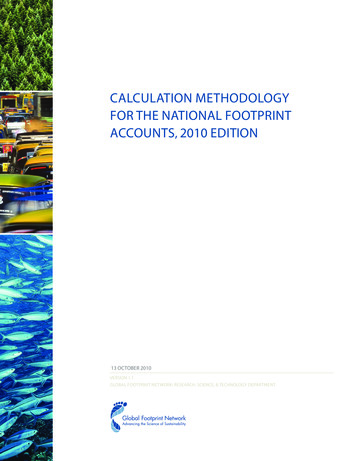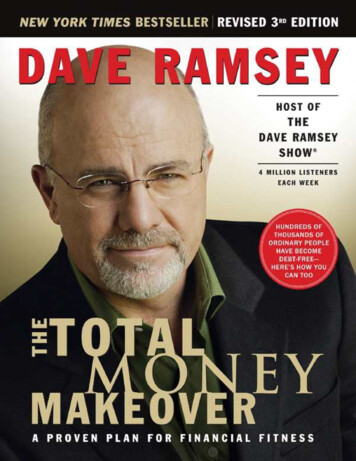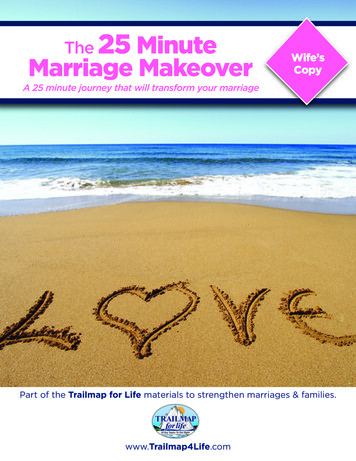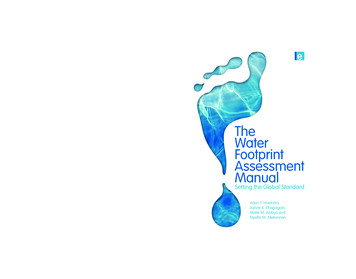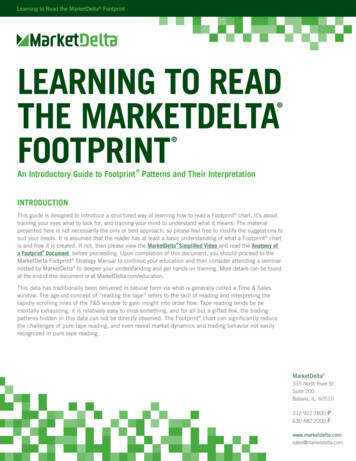
Transcription
“Our Ecological Footprint” Lesson Makeover: 5th gradeBackgroundMy name is Kathleen O’Neill and I am a senior at Eastern Michigan University who ismajoring in elementary education. I designed a three-day lesson plan on the ecological footprintfor a biology class I took in the winter of 2007. The students in my class and I were eachrequired to teach our lessons to a small group of fifth grade students. The test results of the fifthgraders can be found on the last page of this document.My lesson would have not have existed had I not taken a class on social foundationstaught by Susan Santone* at Eastern Michigan University. In her class I was introduced to theEcological Footprint and to the importance of strongly integrating the idea of a healthyecological system into the classroom. Furthermore, my social foundations class and childrenhave taught me how important it is to give children a feeling of purpose in what they do at schooland to connect the curriculum to their lives. All the students live in Canton, MI so some parts ofthe lesson solely concentrate on local information that I found, which directly connected thelesson to my fifth grade audience.My lesson was conceived as an introduction to a larger unit on the ecological footprintbecause it gives children a good foundation and overview to build from. The lesson wasoriginally planned to be taught over two days, a half hour for each day, but when I went to teachthe fifth graders I realized that one hour was not enough time. I had to cut valuable discussiontime short and speed through important information. For this reason, I have adjusted the timeframe to how I would actually teach it in my own classroom.Before presenting my lesson plan, I created a sample “before” Ecological Footprintlesson. This lesson provides much less depth, and is typical of the type of environmentalinstruction I have witnessed in classrooms, especially among teachers not comfortable in science.By comparing the “before” and the “after,” the reader can gain a sense of how a new teacher haslearned to deepen the quality of instruction through increased understanding of sustainabilitycontent and pedagogy.* Susan Santone is the Executive Director of Creative Change Educational Solutions.
“Before” Lesson descriptionLesson: “Ecological Footprint”Grade Level: 5thBenchmarks:I.1.E.1 Ask questions that help students learn about their worldIII.5.E.4 All students will analyze how humans and the environment interactActivities: Students take the “Bobbie Footprint Quiz” online.A class discussion is held on what things adversely impact or help the environment.Teacher explains that doing things that hurt the environment makes your ecologicalfootprint bigger and doing things that help the environment makes your ecologicalfootprint smaller.Assessment: Have students draw and color big and small footprints. Inside the footprints have themwrite different examples of practices that could make them that size. For instance, in thesmall footprint, students could write recycling.“After” lesson begins on the following page.
Name Of Lesson: Our Ecological FootprintThe 5 – Step Learning CycleEngageEvaluatePre-Assessment – Students answer questions aboutthe ecological footprint, overshoot, and sustainability.Teacher will engage the students by showing a posterthat says “It’s our choice”. It has different pictures ofhealthy and unhealthy ecological environmentsStudents will complete the PostAssessment which is similar to the PreAssessment.Title: Our Ecological FootprintElaborateExploreWhat if you were on Canton’s EnvironmentalStewardship Committee and were asked to come upwith 5 of the easiest and best tips for CantonResidents to reduce their ecological footprints. Then,what would be the top 5 tips you would give?Students explore the concept of an ecologicalfootprint by taking the ecological footprintquiz. Students collect and record the group’sdata in a chart.ExplainStudents then fill out a tree map that givesexamples of small and big ecologicalfootprints as the teacher is talking. Teacherwill discuss ecological footprints, overshoot,sustainability, and different types of energyuses.
Title: Our Ecological FootprintGrade level: 5thAlignment TablesStrand ILessonObjectiveMichiganBenchmarkProcessSkill5E stepThinkinglevelStrand IILessonObjectiveMichiganBenchmarkProcessSkill5E rocessSkill5E stepThinkinglevelStrand IIILessonObjectiveMichiganBenchmarkProcessSkill5E stepThinkinglevelStudents will be able to measure their environmental impacts of lifestyle choices bytaking the ecological footprint quiz.I.1.E.1 Ask questions that help students learn about their worldObserving, communicating, and estimatingExploreStructuring, organizing, and relating (orange)Students will be able to show how their ecological footprints were measuredII.1.E.4 Develop an awareness and sensitivity to the natural worldCollecting data, classifying, inferring, and communicatingExplainConvergent generalizationStudents will be able to explain how the size of their ecological footprint impacts theenvironmentII.1.E.2 Show how science is related to other ways of knowingInferring and interpreting data, predicting and communicatingExplainConvergent generalizingStudents will be able to develop strategies to reduce one’s ecological impact on theenvironmentIII.5.E.4 All students will analyze how humans and the environment interactCommunicating and predictingElaborateDivergent thinking
Core Concepts (Big ideas are underlined.)Evidence, Models, and Explanation – These concepts fit with my lesson because we will seeevidence of healthy and unhealthy ecological environments. The footprint model will be used tounderstand our impact on the Earth. We will be able to explain how our ecological footprintsimpact us, other species, and the Earth. At least one of these concepts will be covered in each 5Esection.Characteristics of Living Things (MR. H2O)Interdependence – Our ecological footprints impact the Earth’s environment and the Earth’senvironment impacts us. Humans impact the Earth’s environment because we have the power todestroy it or sustain it. The Earth impacts us because it is our home. This MR. H2O concept willbe covered in each 5E section.Materials Per student (Refer to Appendix and Resource sections) 1 pre-assessment form 1 blank ecological footprint quiz 1 clip board 1 blank ecological footprint tree map Pictures of different energy uses 1 post-assessment formMaterials for Teacher (Refer to Appendix and Resource sections) Poster of healthy and unhealthy ecological environments 1 Pre-assessment with answer sheet 1 computer Audio/Visual materials 1 Ecological footprint tree map with answer sheet 1 data chart 1 Post-assessment with answer sheet Dry erase board to write down students’ ideasConnection to the Real WorldTeacher: Has anyone ever gone to “River Day”? What was it like? “River Day” is a fun eventthat happens every year where volunteers get together to clean Canton’s creeks and streams.Over 400 people volunteered last year. “River Day” also has nature walks and a tent where youcan build bird houses. This is just one of the ways you can help save the environment in yourown community. Has anyone ever been to Fellows Creek Wetland Nature Trail in Flodin Park?The Fellows Creek Wetland improves water quality, reduces pollutants entering the Rouge River,and benefits fish and wildlife. Frogs, butterflies, muskrats, and bats are just some of the wildlifethat live in this area. (See resources)
Day 1Pre-assessment (5 min)Students complete the traditional pre-assessment. (See appendix)Grading Guidelines1 point each for questions 1-3: 3 points1 point for each listing in questions 4 and 5: 6 pointsTotal 9 pointsEngage (10 min)Teacher: Does anyone know who Blue Man Group is? (Teacher plays a short and entertainingpublic service announcement about global warming that Blue Man Group created. See theresources page to find out how to get the video.) Each and every one of has an impact on theEarth. It is up to us to decide what kind of world we want to live in and what kind of world wewant future generations to live in. (Teacher shows a poster that says “It is our choice”. Theposter also shows pictures of healthy and unhealthy ecological environments. (See referencesection) What do you notice about the poster? The unhealthy ecological environments have beencaused by humans but we have the power to clean and restore our environment.Has anyone ever gone to “River Day”? What was it like? “River Day” is a fun event thathappens every year where volunteers get together to clean Canton’s creeks and streams. Over400 people volunteered last year. “River Day” also has nature walks and a tent where you canbuild bird houses. This is just one of the ways you can help save the environment in your owncommunity. Has anyone ever been to Fellows Creek Wetland Nature Trail in Flodin Park? TheFellows Creek Wetland improves water quality, reduces pollutants entering the Rouge River, andbenefits fish and wildlife. Frogs, butterflies, muskrats, and bats are just some of the wildlife thatlive in this area.Explore (20 min)Teacher: Now we are going to explore our concept by taking the ecological footprint quiz.(http://www.myfootprint.org. See resources) If you are not sure how to answer one of thequestions just take a guess. There are no wrong answers. (Students take the quiz. See theappendix) The quiz we just took can be found online and the url address is at the top of yourpage. I had my cousin, Colin, who is also in the fifth grade take the quiz online. Now we are goingto see what it would like if you were to take the quiz online. I wrote down Colin’s answers sothat we can use his as an example. (Teacher then goes to take the quiz online for the students tosee. The results are shown.) We can see from the results that if everyone lived like Colin wewould need two and a half Earths. Now let’s collect some of our groups’ data by sharing ouranswers to the following questions. How much of the food you eat is process, packaged and notlocally grown? On average, how far do you travel by car as a passenger? Do you bicycle, walk oruse animal power to get around? Approximately how many hours do you spend flying eachyear? How many miles per gallon does the car you ride in get? (Students record data in theircharts. (See appendix for a copy of the chart)
Day 2Explain (45 min)Teacher: Please fill in the tree map by listening to me. (Copy of the blank tree map and acompleted tree map can be found in the appendix.) The quiz we took on yesterday measured ourecological footprints. An ecological footprint is the amount of space that is required to supportthe resource needs and waste of a person. Ecological footprints come in all different sizes. If wehave a big ecological footprint this can be called overshoot. Overshoot is when a person takesmore than the earth can renew. If you take out and look at the graph titled, Humanity’sEcological Footprint, you can see that we have a big overshoot. If we have a small ecologicalfootprint this can be called sustainability. Sustainability is when a person takes more than theEarth can renew. If you take out and look at the picture with the buildings, street, and trees youcan see that we can meet our needs and still live in a healthy ecological environment. We are goingto look at some different examples of overshoot and sustainability and try to find ways we cancome more in the middle. Our ecological footprints are calculated by finding out how muchenergy we use. We use energy for food, water, shelter, and mobility. There are differentways we use energy in our home. Take out and look at the picture of the room with the televisionand lamp. What do you notice about the picture? The television is on and the light is on but noone is in the room. Also, the door is open and the heat is being let out. The electricity we usebecomes a waste and creates air pollution. Take out and look at the picture that says “switch itoff”. Switching off electronics, appliances, and lights is a great way to save energy. Another waywe use energy is by transportation. Automobiles and airplanes pollute our environment byburning fuel or oil which is a non-renewable resource and releasing carbon dioxide and other gasesfrom combustion of oil and coal. Take out and look at the picture of the semi truck. What do younotice? You can see the gasoline fumes coming out. Walking, riding a bicycle, carpooling, or ridinga bus are ways we can save energy. Take out and look at the pictures of the person bicycling andthe bus. Do you notice anything about the bus? It is a hybrid which means it has lower miles pergallon which ultimately means that it pollutes less. Take out and look at the convertible. It is aSaturn that gets twenty miles per gallon. Now take out and look at the other car. It is a Ferrarithat only gets ten miles per gallon. That is half the amount of the Saturn. Transportation plays abig part in the food system because food has to be transported from harvest to market, and forprocessing, packaging, and storage. Growing food yourself or buying locally grown food can savea lot of energy in food production. Has anyone ever been to Whole Foods Market in Ann Arbor?All the foods there are local because they traveled less than ten hours away to get there. Foodthat you get from Walmart could come all the way from somewhere like Australia. This sort ofthing especially happens during our winter because the Southern Hemisphere has summer at thattime.(Information on the previous topics can be found in the resource section. See appendix for copiesof the pictures.)
Day 3Elaborate (15 min)Teacher: Does anyone know what an environmental steward is? It is a person who serves theenvironment by doing things to make it a better place to live in. Anyone and everyone can be anenvironmental steward. One example of how we can serve the Earth is to plant trees. Who wouldlike to share another way we can serve the Earth? (Teacher writes down students’ ideas) Did youknow that Canton has an Environmental Stewardship Committee? The committee works toprotect our natural resources. They help to put on events like River Day and try to teach peopleabout ways they can help out our environment. (See resources) What if you were on Canton’sEnvironmental Stewardship Committee and were asked to come up with five of the easiest andbest tips for Canton residents to reduce the size of their ecological footprints? What would thetop five tips be?Optional ExtensionA letter can be written to the school principal proposing the formation of an environmentalstewardship committee.Evaluate (5 min)The evaluation is the same as the pre-test except there is one more additional question will begiven and it is worth 1 point. (See appendix for a blank copy of the post-test and answer key)Science Education Safety Checklist Items1. Always perform an experiment or demonstration prior to allowing students replicate theactivity. Look for possible hazards. Alert students to potential dangers.2. Safety instructions should be given orally and be posted each time an experiment is begun.3. Never eat or drink in the laboratory or from laboratory equipment. Keep personal itemsoff the lab tables.11. Teachers must set good lab safety examples when conducting demonstrations andexperiments. They should model good lab safety techniques such as wearing aprons andgoggles.12. Rough play or mischief should not be permitted in science classrooms or labs.Lesson Plan DifferentiationEnglish as a Second Language – The teacher allows the student to draw pictures for theassessments and during the elaborate section. The teacher also orally reads the ecologicalfootprint quiz and the other assessments.Attention Deficit Hyper Disorder – The teacher writes very clear and short directions forassessments and other activities in the lesson. If the student gets off track the teacher tells thestudent to look back at the directions so that he/she remembers what to do. The teacher makessure it is silent during independent work to reduce the chance of the student being distracted.
ResourcesBlue Man Group, “Earth to America” public service announcement. http://www.youtube.com“It’s Our Choice”. NoE101 It’s our choice. Petersburg, Va. Feenix Publishing Inc.“Fellows Creek Nature Trail”. 2006. Canton Township Website. ��Volunteers make Canton’s River Day a success”. 2006. Canton Township Website.http://www.canton-mi.org/press/2006 press releases.asp? 1340“Community Activities”. 2007. Canton Township Website. http://wwww.canton-mi.org/“Ecological Footprint Quiz”. 2002. Redefining Progress. http://www.myfootprint.orgPictures of different energy uses found within google image search.http://www.images.google.com“2007 Saturn Sky”. 2007. U.S. /23094.shtml“2007 Ferrari 612 Scageitetti”. 2007. U.S. ablef.jsp“Conserve Resources”. 2007. U.S. Government. ical Footprint Resource CD. 2004. Redefining n’s Environmental Stewardship Committee”. 2007. Canton Township pendix Blank pre-test Blank post test Pre and post test answer key Ecological footprint quiz Blank group data chart Picture of blank tree map Picture of completed tree map 5th grade students’ test results and academic gains
Pre-testNameDirections: Please answer the following questions.1.) What measures the amount of space that is required to support theresource needs and waste of a given population or person?2.) What is it called when a person takes more than the Earth can renew?3.) What is it called when a person does not take more than the Earth canrenew?4.) List three things that would make your Ecological Footprint bigger.1.2.3.5.) List three things that would make your Ecological Footprint smaller.1.2.3.
Post-testNameDirections: Please answer the following questions.1.) What measures the amount of space that is required to support the resourceneeds and waste of a given population or person?2.) What is it called when a person takes more than the Earth can renew?3.) What is it called when a person does not take more than the Earth can renew?4.) List three things that would make your Ecological Footprint bigger.1.2.3.5.) List three things that would make your Ecological Footprint smaller.1.2.3.6.) In one or two sentences, explain why you think it is important to make yourEcological Footprint smaller?
Pre and Post Test Answer KeyNameDirections: Please answer the following questions.1.) What measures the amount of space that is required to support the resourceneeds and waste of a given population or person?Ecological Footprint2.) What is it called when a person takes more than the Earth can renew?Overshoot3.) What is it called when a person does not take more than the Earth can renew?Sustainability4.) List three things that would make your Ecological Footprint bigger.1. Not recycling2. Turning up the heat really high all the time in my house3. Taking a one hour shower5.) List three things that would make your Ecological Footprint smaller.1. Turn off the lights in my house2. Stop drinking from water bottles and instead reuse one cup with a lid3. Use a real plate instead of a paper plate.6.) In one or two sentences, explain why you think it is important to make yourEcological Footprint smaller?It is important for me to make my Ecological Footprint smaller because I want tolive in a clean environment.
Ecological Footprint Quiz can be taken online at http://www.myfootprint.orgNameDirections: Please answer the following questions.Food Footprint1. How often do you eat animal base products? (beef, pork, chicken, fish, eggs, dairyproducts)a. Never (vegan)b. Infrequently (no meat, and eggs/dairy a few time a week) (strict vegetarian)c. Occasionally (no meat or occasional meat, but eggs/dairy almost daily)d. Often (meat once or twice a week)2. How much of the food that you eat is processed, packaged, and not locally grown(from more than 200 miles away)?a. Most of the food I eat is processed, packaged, and from far awayb. Three quartersc. Halfd. One quartere. Very little. Most of the food I eat is unprocessed, unpackaged, and locally grownGoods Footprint3. Compared to people in your neighborhood, how much waste do you generate?a. Much lessb. About the samec. Much moreShelter Footprint4. How many people live in your household?a. 1 personb. 2 peoplec. 3 peopled. 4 peoplee. 5 peoplef. 6 peopleg. 7 or more people
5. What is the size of your home?a. 2500 square feet or largerb. 1900-2500 square feetc. 1500-1900 square feetd. 1000-1500 square feete. 500-1000 square feetf. 500 square feet or smaller6. Which housing type best describes your home?a. Free standing house without running waterb. Free standing house with running waterc. Multi-story apartment buildingd. Row house or building with 2-4 housing unitse. Green-design residence7. Do you have electricity in your home?a. Nob. Yesc. Yes, with energy conservation and efficiencyMobility Footprint8. On average, how far do you travel on public transportation each week (bus, train,subway, or ferry)?a. 200 miles or moreb. 75-200 milesc. 25-75 milesd. 1-25 milese. 0 miles9. Ona.b.c.d.e.average, how far do you go by motorbike each week as a passenger?200 miles or more75-200 miles25-75 miles1-25 miles0 miles
10. Ona.b.c.d.e.f.average, how far do you go by car each week as a passenger?400 miles or more300-400 miles200-300 miles100-200 miles10-100 miles0 miles11. Do you bicycle, walk or use animal power to get around?a. Most of the timeb. Sometimesc. Seldom12. Approximately how many hours do you spend flying each year?a. 100 hoursb. 25 hoursc. 10 hoursd. 3 hourse. Never fly13. How many miles per gallon does the motorbike you ride in get?a. More than 80 miles per gallonb. 65-80 miles per gallonc. 45-65 miles per gallond. 30-45 miles per gallone. Less than 30 miles per gallon14. How many miles per gallon does the car you ride in get?a. More than 50 miles per gallonb. 35-50 miles per gallonc. 15-25 miles per gallond. Fewer than 15 miles per gallon
Group Data ChartHow much of the food you eat is process, packaged, and locally grown?Most ofthe foodThreeQuartersHalfOneQuarterVerylittleOn average, how far do you travel by car as a 00miles10100miles0milesApproximately how many hours do you spend flying each year?100hours25hours10hours3 hoursNeverflyHow many miles per gallon does the car you ride in get?More than50 miles pergallon35-50 milesper gallon15-25 milesper gallonFewer than15 miles pergallon
Picture of Blank Tree MapPicture of Completed Tree Map
Test ResultsThe graph below shows the pre and post test scores of the 5th grade studentsI taught. The blue bars indicate the before score and the red bars indicate the afterscore. Students who received a zero for the before score will not have a blue bar.
footprint bigger and doing things that help the environment makes your ecological footprint smaller. Assessment: Have students draw and color big and small footprints. Inside the footprints have them write different examples of practices that could make them that size. For instance, in the small footprint, students could write recycling.


